Forums:
Juno season has started again.
Here some pictures to show you the variability of iris rosenbachiana:
photo 1-2 = "Deep Purple"
3-4 = "Varzob"
5 = "Harangon"
6-7 = "Tovilj-Dara"
8-9 = unnamed selection from the wild

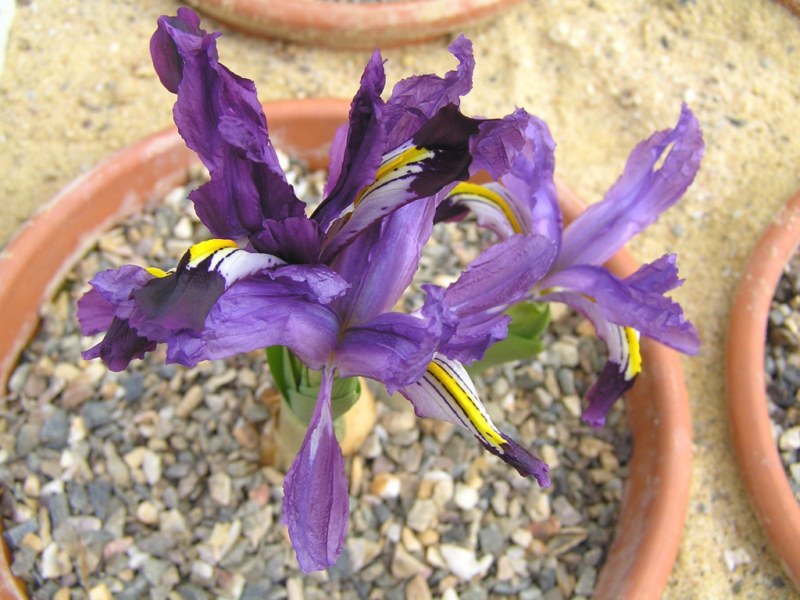
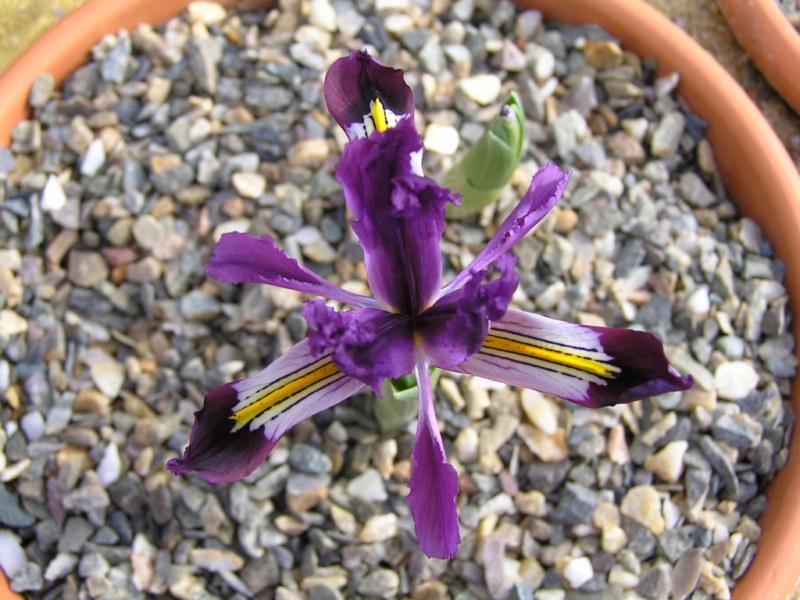
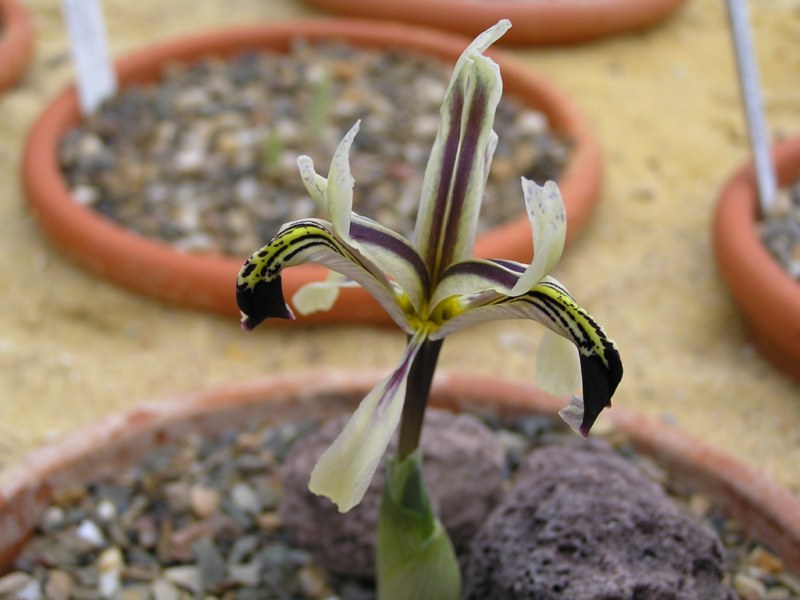

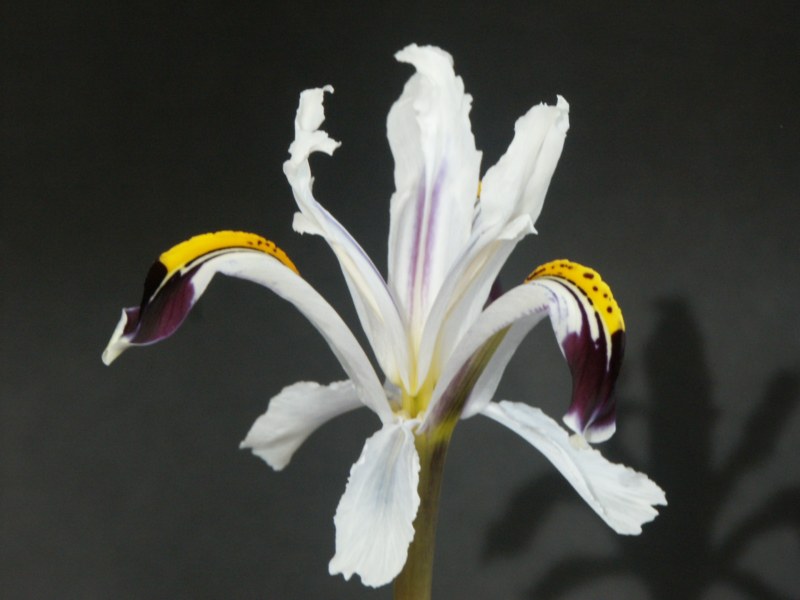
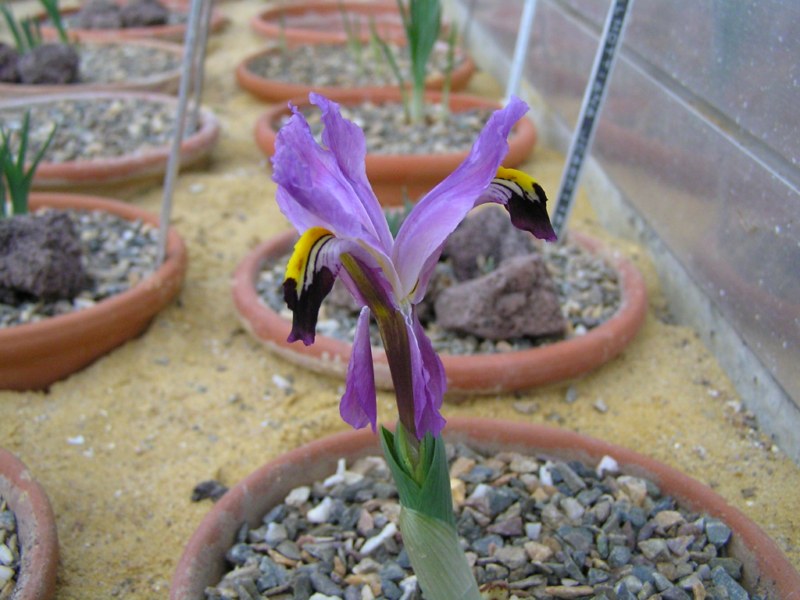
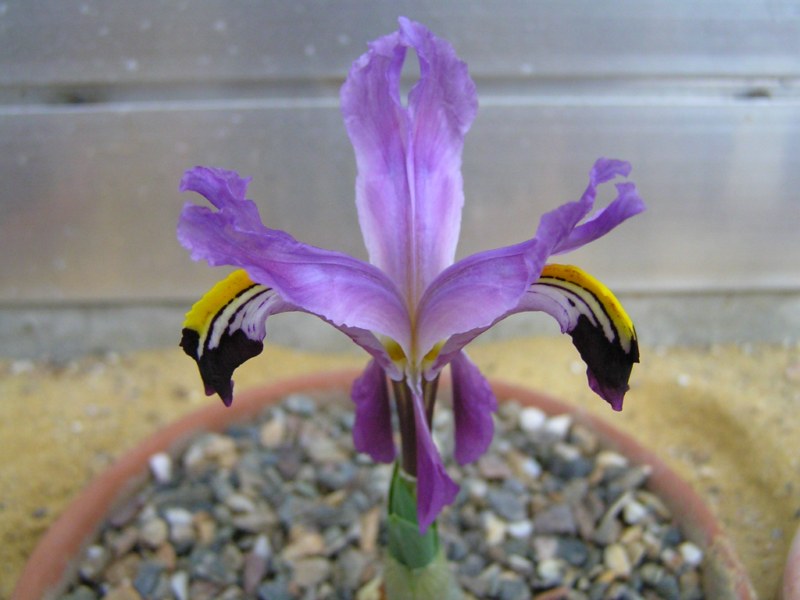
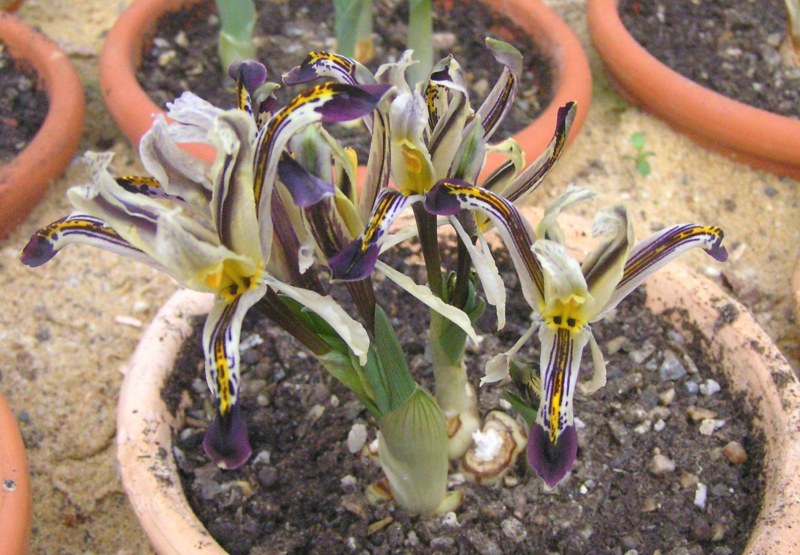

Comments
Amy Olmsted
Re: Iris 2011
Tue, 03/15/2011 - 4:02pmI saw this lovely I. unguicularis growing in a garden at Pine Knot Farm last week. It's too bad they aren't hardy for the north, the color is so pretty and the flowers are nice & big.
Richard T. Rodich
Re: Iris 2011
Tue, 03/15/2011 - 8:25pmObviously, my head was somewhere else when I was (thinking I was) reading your post, Mark. ;D
WimB (not verified)
Re: Iris 2011
Thu, 03/17/2011 - 2:07amIn flower here today; for the first time:
Iris aucheri 'Shooting Star'
LucS (not verified)
Re: Iris 2011
Thu, 03/17/2011 - 7:18amThe plant stays in winter under glassroof but unprotected from the cold. It is nearly evergreen with me.
I think that a rather dry and hot summer is necessary to induce spring flowering.
LucS (not verified)
Re: Iris 2011
Mon, 03/21/2011 - 10:20pmTwo more juno iris starting to flower:
Iris graeberiana in one of its froms
Iris willmottiana
LucS (not verified)
Re: Iris 2011
Mon, 03/21/2011 - 10:23pmAnd from a different group in the iris family :
Iris flavissima
Iris tygridia
Mark McDonough
Re: Iris 2011
Tue, 03/22/2011 - 6:52amLuc, both of these are lovely Iris, glad to "meet" them. Not knowing much about them nor what Iris section they are in, I had to look them up. Still not sure what section I. flavissima is in, photos show a brighter yellow flower, although I much prefer your exquisite form with delicate markings. Found photos of a pale yellow form here (scroll down):
http://plantes-passion.forumactif.fr/t411-iris-flavissima
...and a European nursery offering a darker yellow form:
http://www.rareplants.de/shop/product.asp?P_ID=8865
...Flora of China entry:
http://www.efloras.org/florataxon.aspx?flora_id=2&taxon_id=200028168
Iris tigridia is a little beauty, I would grow that one in a heartbeat, it is section Pseudoregelia. John Lonsdale grows it outdoors, which gives some promise that it is growable outdoors here in New England, NE USA.
http://www.edgewoodgardens.net/plants_album/the%20plants%20-%20%20comple...
LucS (not verified)
Re: Iris 2011
Tue, 03/22/2011 - 7:44amHey Mark,
Brian Matthew regards this species as being the same as Iris arenaria and Iris humilis.
Iris flavissima has its distribution in E-Europe.
Mark McDonough
Re: Iris 2011
Tue, 03/22/2011 - 8:43amYes indeed, the FOC link above states "Iris flavissima is here treated as a distinct, E Asian species, but is often placed in synonymy under the widespread, Eurasian species I. humilis Georgi ( I. arenaria Waldstein & Kitabel)."
Do you know where your beautiful pastel form is from?
LucS (not verified)
Re: Iris 2011
Sun, 03/27/2011 - 1:07pmMark,
This one is grown from 2003 seed collected by Pavelka in de Changai Mtns, Mongolia, alt. 2500m
Mark McDonough
Re: Iris 2011
Sun, 03/27/2011 - 1:58pmThanks Luc... it seems worthy of a cultivar name, such a beauty.
LucS (not verified)
Re: Iris 2011
Mon, 03/28/2011 - 1:26pmSome more junos in flower
Iris magnifica from wild collected seeds (Uzbekistan), without the usual blue shade
Iris bucharica "Swan Wings"
Iris warleyensis
Iris bucharica x vicaria, a 1st generation hybrid
Mark McDonough
Re: Iris 2011
Tue, 03/29/2011 - 4:53amGorgeous Junos Luc! Up until a few years ago, when deer came in an ate all my Junos to mere nubs (which had the effect of weakening the bulbs and introducing rot with severed leaf-bases catching moisture, decimating my large clumps), I had two forms of I. magnifica, one with the typical tinge of blue, but the other a clean white. Neither were of known provenance.
'Swan Wings' is aptly named, really beautiful delicate ascending "wings" on that one, I'm not familiar with this cultivar. Good to see what pure I. warleyensis looks like, very pretty.
On your Iris bucharica x vicaria 1st generation hybrid, is this a hybrid of your own creation? I don't see much evidence of vicaria in it, I would assume such a cross would show a bit of blue in the flower, but I know very little about Juno crosses and what plant characteristics prevail in hybrid progeny.
LucS (not verified)
Re: Iris 2011
Thu, 03/31/2011 - 12:05pmMark,
This juno hybrid was grown from Alan McMurtrie seeds distributed via the Archibald list.
LucS (not verified)
Re: Iris 2011
Thu, 03/31/2011 - 12:07pmA few more:
Iris bucharica x warleyensis "Blue Warlsind"
Iris mandshurica
Mark McDonough
Re: Iris 2011
Fri, 04/01/2011 - 2:25pmWonderful seeing photos of Iris mandshurica, darn near impossible to find a photo of this small Iris on the web. I know it from "Iris of China" by James Waddick and Zhao Yu-tang; inside there's a good photo of this small pseudoregelia. It is not found at terribly high elevations, but since it is also found in the USSR, it suggests this species would be hardy outside. Luc, I may sound like a broken record, but can you tell us where you obtained this little goodie?
LucS (not verified)
Re: Iris 2011
Sat, 04/02/2011 - 11:57pmFound it at an AGS show last year.
LucS (not verified)
Re: Iris 2011
Sun, 04/03/2011 - 12:02amThis is a plant I got as Iris chamaeiris but because of priority of names it should be called Iris lutescens.
This is the violet clone with the typical yellow beard.
Iris lutescens is a plant of dryish grassy places occuring in NE-Spain, S-France and Italy.
WimB (not verified)
Re: Iris 2011
Sun, 04/03/2011 - 1:41amTwo Juno's in flower here today:
Iris x graeberiana 'Yellow Fall'
Iris vicaria 'Hodji-Obi-Garm'
LucS (not verified)
Re: Iris 2011
Mon, 04/04/2011 - 11:45amTwo more in flower today:
Iris reichenbachii from the Balkan
Iris taurica in a nice blue form
Amy Olmsted
Re: Iris 2011
Mon, 04/04/2011 - 5:36pmLuc!! Absolutely gorgeous...well done! I'm getting more into species Iris these last couple of years and have orderes quite a few from the seed-ex. Wish me luck!
Richard T. Rodich
Re: Iris 2011
Mon, 04/04/2011 - 9:04pmI didn't know Iris reichenbachii came in a purple form! Very nice, Luc!
Amy, be sure to hold your seeds over for at least two years if they don't germinate the first season. There can always be the odd deviant seed, but some species need 2-3 cold treatments for best germination.
Best of Luck!
LucS (not verified)
Re: Iris 2011
Thu, 04/07/2011 - 12:30pmIris reichenbachii is very variable Rick. I have plants with yellow, brownish-yellow, wine-red and purple flowers.
WimB (not verified)
Re: Iris 2011
Fri, 04/08/2011 - 4:56amA few Irisses in flower here this week:
Iris attica
Iris orchioides 'Aktash'
Iris sari 'Manissadjani'
Amy Olmsted
Re: Iris 2011
Fri, 04/08/2011 - 5:24pmAmy, be sure to hold your seeds over for at least two years if they don't germinate the first season. There can always be the odd deviant seed, but some species need 2-3 cold treatments for best germination.
Best of Luck!
[/quote]Thanks for the info Rick! I've got I. tectorum growing well now and a few others have just poped up with this warm weather after spending the winter outdoors under fleece blankets & plastic tarps.
LucS (not verified)
Re: Iris 2011
Fri, 04/15/2011 - 10:24amIris ruthenica nana always flowers between the leaves, but the individual flowers are nice.
LucS (not verified)
Re: Iris 2011
Fri, 04/15/2011 - 10:31amFrom the onco-iris group:
Iris lycotis
Iris paradoxa
Iris iberica ssp elegantissima
Richard T. Rodich
Re: Iris 2011
Fri, 04/15/2011 - 3:26pmI have Iris ruthenica from seed sprouted last season. I'm a little disappointed that the flowers will be hidden. Still a nice plant, though. But those oncos are fantastic! I see why iberica is so sought after.
Lori S. (not verified)
Re: Iris 2011
Fri, 04/15/2011 - 5:44pmStunningly beautiful Iris species, Luc! I can hardly think of anything more exotic-looking!
I have been told by a local expert alpine gardener that Onco irises do well here - something I must try my hand at some day.
Richard T. Rodich
Re: Iris 2011
Fri, 04/15/2011 - 8:29pmReally? Outside in zone 3? Unbelievable! Obviously, the seasonal climatic changes must mimic their natural haunts, but who would have thought they could take such cold!
cohan (not verified)
Re: Iris 2011
Fri, 04/15/2011 - 11:22pmLuc, those oncos are gorgeous! Lori's news is encouraging, though my climate is not as dry...maybe with the right siting..
LucS (not verified)
Re: Iris 2011
Sat, 04/16/2011 - 1:32amMost of the Turkish species do experience lots of cold in wintertime.
What they need is a dry rest after they die down in June/July. So a rain-cover is essential.
Lori S. (not verified)
Re: Iris 2011
Sat, 04/16/2011 - 8:37amExcess moisture is not a problem here!
WimB (not verified)
Re: Iris 2011
Sun, 04/17/2011 - 11:04amLuc, you're a real master.
Some Irisses flowering here now:
Iris acutiloba
Iris attica
Iris bloudovii
Richard T. Rodich
Re: Iris 2011
Sun, 04/17/2011 - 10:21pmIris acutiloba, stupendous !!!
I think of the joy my silly Iris suaveolens types give me, and Wim, you must have a permanent grin on your face!
How tall is that?
WimB (not verified)
Re: Iris 2011
Sun, 04/17/2011 - 11:05pmI laugh a lot, that's a fact, but it's not always because of the plants I grow! ;D ;D ;)
It's only 12 cm tall (flower included).
cohan (not verified)
Re: Iris 2011
Mon, 04/18/2011 - 10:48amAll lovely Wim--the clump of attica is fantastic :)
Lori S. (not verified)
Re: Iris 2011
Mon, 04/18/2011 - 6:01pmVery nice, Wim - especially Iris acutiloba. :o :o
Iris attica is one of those confusing ones that comes in both yellow and purple (I have the latter):
http://www.pacificbulbsociety.org/pbswiki/index.php/GardenBeardedIrises
Todd Boland
Re: Iris 2011
Tue, 04/19/2011 - 1:57pmWe had a talk about Iris attica and relatives at the International meeting...they come in more than just yellow and blue! Wish I could grow these juno and oncos. heck, I'm lucky I can get reticulata to come back each year.
Speaking of, my Kathleen Hodgkin opened yesterday.
Amy Olmsted
Re: Iris 2011
Wed, 04/20/2011 - 10:54amAll gorgeous plants! And Todd, it must be so nice to have most/some of the snow gone off your gardens! We've still got a few piles here & there, now if the weather would only warm up just a little we might actually have a spring! :-\
Mark McDonough
Re: Iris 2011
Wed, 04/20/2011 - 7:29pmWonderful Iris everyone, too many to comment on here in my "hit and run" quickie posts during the work week. Here is Iris x 'Sindpers' which flowered well this year, it skipped blooming for the past two years! I love the pure sky blue color, and nearly stemless growth. It has been grown outdoors in the garden for nearly 10 years.
LucS (not verified)
Re: Iris 2011
Fri, 04/22/2011 - 9:42amAn old but always attractive hybrid.
LucS (not verified)
Re: Iris 2011
Fri, 04/22/2011 - 9:44amAn onco-iris in one of its colourforms not shown before: Iris sari
WimB (not verified)
Re: Iris 2011
Sat, 04/23/2011 - 1:19pmA very beautiful form of Iris sari, Luc.
Some Irisses in flower here now:
Iris schachtii
and some small bearded Irisses:
'Forever Blue'
'Open Sky'
and a cultivar of which I forgot the name.
Trond Hoy
Re: Iris 2011
Sat, 04/23/2011 - 11:54pmIt seemingly liked your warm and dry spring/summer last year!
I have almost given up growing these showy Irises. Have a few other types though :(
Panayoti Kelaidis
Re: Iris 2011
Sun, 04/24/2011 - 8:14amJust browsed and saw lots of great irises: I was struck by the I. schachtii in Wim's post: many of our bearded dwarfs are blooming too, and this is one I used to grow in that honey gold form and miss! I was also surprised by the albino I. flavissima (or humilis or whatever)... I admire how you all can grow junos and Oncocylus in pots: we grow them all in the ground since if we tried growing them in pots I am sure we would kill them. And our climate approximates their conditions and they seem to like it here: the following are a few of the later junos that are still blooming (we have had a fabulously cool spring so plants last forever, although with just traces of rain every week, we could use a good soak from Mother Nature)...
I believe the last one (labeled Iris sp.) is I. narbutii...any opinions?
Iris graeberiana
Iris henryi
Iris vicaria
Iris warleyensis
Iris x Warlsind
Iris orchioides
Iris bucharica
Iris willmottiana
Todd Boland
Re: Iris 2011
Sun, 04/24/2011 - 3:32pmSpectacular Junos PK! I cannot even get I. bucharica to survive more than 2 years :'(
cohan (not verified)
Re: Iris 2011
Sun, 04/24/2011 - 6:28pmWow! So many beauties! Luc, the oncos are incredible!
Panayoti--great species! orchioides and the last sp are really amazing! I'll need to come back to this thread next time I am looking at a seedlist!
WimB (not verified)
Re: Iris 2011
Tue, 05/03/2011 - 6:09amSome Irisses flowering here now:
Iris cristata var. alba (not very easy to find this species her in Belgium)
and Iris inominata
Mark McDonough
Re: Iris 2011
Sat, 05/07/2011 - 8:18pmI'm late to respond here, but respond I must, some really good stuff here!!!
@PK - The Iris bucharica in Colorado are out of control, certainly an insidious weed that needs government intervention! ;D Never have I seen such clumps. Have you tried Round-Up on them ;D The junos certainly seem to like the Colorado climate. Exceptional!
@Wim - one of my great desires is to successfully grow I. innominata and other Western USA coastal mountain Iris. The brown veining in your form is most fetching. Glad you managed to acquire Iris cristata alba, a very good white; was at Garden Vision Epimedium nursery today, and feisty pots of I. cristata alba are just a mere $6, a flat of petunias might cost more!
Pages